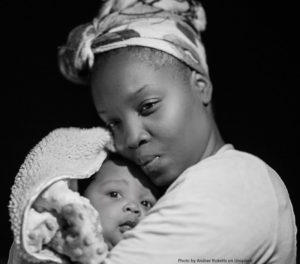Spring Issue Articles
Written by Mary Jane Maguire-Fong and Marsha Peralta
Reviewed by Nancy Eichhorn
Personal interest and academic requirements in prenatal and perinatal psychology and health (PPN) meant reading literature and learning from leaders in the field. I’ve immersed myself and I’ve been guided through the work of many luminaries including, but clearly not limited to: Stella Acquarone, Beatrice Beebe, T. Berry Brazelton, Jerome Bruner, Magda Gerber, Jaak Panksepp, Bruce Perry, Daniel Stern, Ed Tronick, D. W. Winnicott, Ronald Lally, and Donis Eichhorn PhD.
Yes, Dr. Eichhorn is my mom. Throughout her career she’s been recognized for her involvement in the field as well as being “on-the-cutting-edge” educating educators as well as families. For as long as I can remember, we have attended conferences and workshops together, and with later age and limited mobility, online webinars as well.
Two of her colleagues, Mary Jane Maguire-Fong and Marsha Peralta, recently published, Infant and Toddler Development: From Conception to Age 3. What Babies Ask of Us. In their “Preface”, they acknowledged my mom as a colleague and friend who has been “a source of wisdom, counsel, and inspiration in this work” (pg. x). Peralta noted, “We have so appreciated her contributions to our thinking and perspective” (personal correspondence, November 28, 2018).
I felt honored by their nod to my mom—she has been, and at age 89 continues to be, inspirational. Her work with parents and infants, from preconception through the first 5 years of life, created awareness and change during times when infants were not recognized in mainstream medical and psychology fields as conscientious beings but rather as a ‘bundle of joy’ that needed to be taught how to be and who to be in order to survive in this world.
Studies have, in fact, supported my mom’s and others’ points-of-view when it comes to fetal sentience and abilities online at birth. And, based on incoming data, transitions have thankfully occurred—infants were once viewed as immature, undifferentiated, unknowing beings. Now, they are seen as competent and actively participating in their care, with behaviors actually primed by their biology to be in relationship with others (p.2).
Maguire-Fong and Peralta have added their combined knowledge to a field still in transition. Their recent publication, along with its Foreward by J. Ronald Lally and Afterward by Ed Tronick, offers insights and research from an academic and clinical vantage for readers interested in PPN work. And, as an added positive, it is also written to engage and instruct laypersons interested in knowing more. Lally considers Chapters 2 through 4 “must reading for anyone considering having a child.”
 As Lally notes, this book “ . . . clearly and purposefully communicates, in direct and easily understandable language, the day-by-day development of infants and the essential role adults play in the optimization of that development” (Lally, pg. vii).
As Lally notes, this book “ . . . clearly and purposefully communicates, in direct and easily understandable language, the day-by-day development of infants and the essential role adults play in the optimization of that development” (Lally, pg. vii).
Maguire-Fong and Peralta hope that the book serves as a guide in making meaningful sense of infants’ development from pre-conception through the first 3 years of life as well as being a detailed guide for those responsible to care for them (pg. ix). They offer their work as an invitation for readers to take a closer look at “how we see babies, to sharpen our understanding of what babies know, how they feel, how they relate with others, and how they learn” (p. 1).
Although both authors have extensive backgrounds in the field as clinicians and educators, their foundational information for this book is based on current understandings derived over the past 50 years from research studies and their findings in infant development that culminate, summarize, and open understanding regarding how infants operate, change, and grow, and most importantly what they need from caregivers. According to the authors, “How adults understand and treat infants directly affects the rest of the child’s life and influences evolution of the species.”
According to Lally, the research cited and interpreted in chapters 5 – 11 clearly illustrates how infant development progresses, how we understand the underlying structures that are gradually built through the first 3 years of life, and how most of the building takes place in relationship with trusted adults.
“There is no such thing as a baby . . . A baby cannot exist alone, but it is essentially part of a relationship”
(D. W. Winnicott, 1964, 88).
Maguire-Fong and Peralta organized the book into four parts to answer two primary questions: “What do babies ask of us?” and “How do we see our role as a traveling companion to the meaning-making infant?”
Each chapter tells a story of what researchers are learning about infants in a particular domain of development (p. 1). From Winnicott’s pronouncement that infants are not blank slates, to Bowlby and Ainsworth’s research with attachment and Daniel Stern’s work with affect attunement (the affect of one influences and potentially changes affect of other), Maguire-Fong and Peralta are clear that babies arrive with biological expectations that they hope to find within their environment, and in the care they seek. They need and want connection, participation, belonging, meaning-making, and companionship. Infants arrive at birth more conscious, more aware, more inquisitive and more capable than previously imagined (p. 1). Today we know that a biological and physiological synchrony exists between infant and caregiver, with infants acutely sensitive to communicative cues of others (p. 3).
In terms of the actual structure and layout of the book, there are extensive photos, graphics, charts, and other aids to facilitate understanding. Each section has separate boxes called “A Closer Look” that offer guided reflections based on a summary of the content presented thus far; important points to recall and retain are highlighted. There are definitions, charts of terms, and an extensive reference list. The authors weave in content from previous chapters, offer reviews, reminders, and extensions for readers to move forward into next stage of infant development. Their tone, the delivery of data with terms defined in text and in sidebars sets an introductory feel to the topics presented, a primer to teach those with little to no background in PPN. I appreciated their clarity when using specific terms such as ‘parent’ to describe the caregiver who is emotionally meeting the demands of parenting, and ‘mother’ when appropriate— when speaking of the birthing mother. They do their best to avoid gender related terminology.
Chapter 1 begins before Part 1 (there are four parts, 13 Chapters). Entitled, Infants and Toddlers: How We See Them, Chapter 1 sets the stage for all that follows. Of importance are five areas of development that continue throughout our lives: connection, participation, belonging, meaning-making, and companionship. Maguire-Fong and Peralta are clear that “babies have much to teach us, and the most important task for us in caring for babies is to listen to them well” (p. 1). Throughout the book, they show us how babies arrive primed to be in relationship, and how they seek, from their caregivers, what they need to grow and thrive.
An Overview
Part 1 focuses on development, conception through birth. It begins with Chapter 2: From Stardust to Birth, an overview of conception and parental development with attention to how experiences during gestation impact development. They discuss how development unfolds from cellular beginnings to our nervous system development. And they highlight negative impacts of alcohol, drugs, other substances. Chapter 3, Labor and Birth, explores babies’ biological expectations for birth and their active participation in the birth process. They discuss hormones that prepare mothers for birth, different labor greets the baby supports those expectations. They highlight how newborns and young infants seek nourishment, warmth, and protection from their caregivers, and they look at our social engagement system and its role in responsive caregiving. Chapter 5 discusses the inherent biological synchrony between mom and baby during lactation and breast feeding. Chapter 6 keeps with the theme of synchrony with respect to patterns of sleep and decisions families face when dealing with sleep. According to the authors, the care infants receive during meals, diapering, and preparing for sleep influences their physical health and how they learn and how they feel about themselves and others (p. 53) positions that facilitate birth, cervix dilation rates, and different states of birth: active, birth, and the delivery of the placenta 15 to 20 minutes after the infant is born, which marks the true severance of the biological connection between infant and mother. They talk about the importance of not rushing the cutting of the umbilical cord, letting the mother and infant be together, noting that the first hour should be preserved as a sacred time of meeting. They also talk about optional birth support and the role of Doulas. The authors also note ways to avoid unnecessary routine medical procedures, which can traumatize both infant and mother.
Part 2 covers Newborns and Responsive Care.
Overall, they stress ways for caregivers to pay attention to the physiological synchrony that exists between babies and themselves, so they can provide appropriate physical and emotional care. Chapter 4 takes a close look at biological expectations during the first hours and days of birth, including how the environment that greets the baby supports those expectations. They highlight how newborns and young infants seek nourishment, warmth, and protection from their caregivers, and they look at our social engagement system and its role in responsive caregiving. Chapter 5 discusses the inherent biological synchrony between mom and baby during lactation and breast feeding. Chapter 6 keeps with the theme of synchrony with respect to patterns of sleep and decisions families face when dealing with sleep. According to the authors, the care infants receive during meals, diapering, and preparing for sleep influences their physical health and how they learn and how they feel about themselves and others (p. 53)
Part 3 is focused on Babies Making Meaning. Chapter 7 details how infants pay close attention to the dynamics of conversation and how this leads to language acquisition. Chapter 8 looks at how infants figure out the complexities of movement, including both small muscle use such as reach and grasp, and large muscles, including crawling. Chapter 9 looks at how infants make sense of people and how play interacts in development. Chapter 10 then looks at how infants build ideas and concepts within play and how they learn about their physical world, and the world of objects and events.
“We speak with more than our mouths. We listen with more than our ears”
(Fred Rogers, 2002, p.116)
When people ask me about my writing life, i.e., when I started and so forth, I jokingly say I was finger painting in the womb. Turns out, I might have been. According to Maguire-Fong and Peralta, language begins in the womb. At 14 weeks gestation, the structures of our vestibular system are mature (the sensory system related to balance, spatial orientation, coordination, balance). Prenatal rhythmic stimulation (i.e. rocking, swaying) “most likely establishes an innate sensitivity patterns that sets a foundation for beginning to understand the rhythmic cadence of language” (p. 73). Around 30 weeks gestation, brain regions that control hearing mature and infants show sensitivity to sound. “Fetuses respond to mothers’ heartbeat and to external stimuli, such as voice, speech, song and music” (p. 73). The entire section on language and correspondence fascinated me.
As did the chapter on the biological use of play. The authors’ focus on how babies learn through touch was rich with specifics for caregivers to encourage different experiences designed to support development, i.e. batting at objects first then developing grasping, starting with palmar and then the pincer grasp. They then offer detailed information and experiences to address: classification, causality, spatial relationships, numbers and representation.
Part Four: Widening the Lens, looks at family and community first then outward to address cultural influences and impacts. Chapter 11 deals with the biological expectations that come with a sense of belonging to a caring social group, how infants build friendships, how they learn expected values and behavior in the culture they are raised. Chapter 12 looks at what happens when infants experience adversity or trauma, and how supportive intervention can begin to heal its impact (they include information on ‘ACES’ a long-term study looking at adverse childhood experiences, note there is a useful graphic on page 141 that frames these experiences and building community resilience). And Chapter 13 returns to the overall guiding question: what do babies ask of us? Here, the authors look at baby friendly policies that align with infants’ biological expectations, support their optional development, and treat babies and families with dignity and respect.
Within several email correspondences regarding the book, Peralta noted that it is not all-inclusive, that it was meant to be an overview, an introduction. And like most writers that I know, myself included, she shared, “I’m nervous about the reviews, but hope you find what’s inside “good enough” (personal correspondence, November 28, 2018).
I appreciated her reference to Winnicott’s “good enough mother”. I’ve heard this term many times in many instances and thought it simply meant the mother was generally fit to be a mom, it wasn’t about perfection but at least she was there. Reading this book, I learned what Winnicott meant by the phrase “good enough mother”. Per Winnicott, infants are “born with unique and individual potentials” that they bring to relationships but “these potentials can only be realized when there is a responsive, holding environment provided by what he described as a ‘good enough mother’” (p.2):
“ ‘Good enough,’ in Winnicott’s view, is a mother who is positively preoccupied with her child, who adapts her behaviors fairly extensively to the needs of the baby, gradually stepping back to allow infants’ competencies to take hold as they emerge over the first year” (p.2).
This book is clearly “good enough”. As Peralta noted in an email conversation, books “are like friends and one has this relationship with them, when they came into your life, how they shaped you, etc.” (personal correspondence, February 18, 2018). She and Maguire-Fong were preoccupied with the birthing of this text. They nurtured it during the editing and revision phase. They stepped back when professional editors offered insights. The authors, working in relationship with one another and with editors at Teachers College Press, allowed one another’s and outside others’ knowledge to support the book’s competencies to flourish as they emerged both spontaneously and with guidance and support. The authors’ ability to be with the material, to attune to both the text and to perceived audience needs, to offer support as readers experienced the content and found their way into their own understanding flowed with the content itself. They wrote from a PPN base about PPN concepts—the two were one, resulting in an effective offering of current knowledge about what babies ask of us and what we can do to meet those needs.
Mary Jane Maguire-Fong is faculty emerita in early childhood education at American River College, in Sacramento, California and author of Teaching and Learning with Infants and Toddlers.
Marsha Peralta is professor of early childhood education at Folsom Lake College in Folsom, CA.








